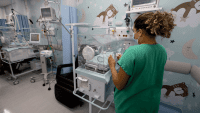Takeaways:
- The COVID-19 pandemic has altered clinical experiences for many schools of nursing so that some students and new graduates may be less prepared for the “reality” of nursing practice.
- The demands of being asked to precept students and new graduates, in addition to caring for patients during COVID-19, can create situations ripe for increased levels of frustration and burnout among nurse preceptors.
- This article provides tips and evidence-based strategies for nurses to help maximize the precepted experience and maintain balance in professional work.
Strategies for effective precepting during challenging times
Editor’s note: This is an early release of a web exclusive article for the March 2021 issue of American Nurse Journal.
Precepting students and new graduates is demanding under the best of circumstances, but adding COVID-19 into the mix makes it even more so. Limited resources, fatigue, and burnout can affect how you engage with preceptees. The tips in this article will help you make the most of precepting during this global pandemic.
Acknowledge limitations
Nursing schools everywhere were catapulted into an alternate reality in early 2020 when the United States declared the COVID-19 pandemic a national emergency. Plans for normal semesters were disrupted as many universities moved to online teaching and clinical sites began to close their doors to healthcare students, ending placements that already may have been difficult to obtain. Nursing faculty scrambled to adapt as many institutions moved in-person clinical experiences to virtual environments. Months later, these virtual and alternative clinical settings may still be integrated into academic courses even as facilities resume student rotations. The degree to which this occurs depends on the individual school, the healthcare facility, and boards of nursing and state government COVID-19 guidelines.
As a preceptor, you need to understand the implications of this change in the landscape. For example, students and new graduates may have had much less face-to-face clinical experience with patients. As a result, new graduates may have less understanding of the reality of nursing. You should be prepared to meet the preceptee where they are by considering Patricia Benner’s novice to expert model. (See From novice to expert.)
From novice to expert
Based on the Dreyfus model of skill acquisition, Benner’s novice to expert model describes five levels of nursing practice competence. Each level is achieved through exposure to clinical situations that changes the way the nurse perceives them and then reacts.
Level 1: Novice
- No experience with the situation
- Views clinical situations in terms of objective pieces of information (for example, weight, blood pressure, temperature) and performs tasks based on rules
- Needs direct guidance from preceptor or faculty
Level 2: Advanced beginner
- Has very limited experience with clinical situations
- Begins to identify recurrent, meaningful information but still needs guidance from preceptor or faculty
- Needs help prioritizing and differentiating meaningful clinical data
Level 3: Competent
- Sees nursing actions in terms of long-term goals or plans
- Can identify which pieces of clinical information are most important but lacks speed and flexibility found in higher levels
Level 4: Proficient
- Has enough experience to see clinical situations as wholes, instead of parts, improving decision making
- Begins to anticipate outcomes in clinical situations and can modify actions to respond with a bit more speed
Level 5: Expert
- Relies on intuition from years of experience and a deep understanding of the clinical situation to guide actions
- Can zero in on problems quickly
According to Benner, nursing students typically are considered novices, and for the first 1 to 2 years, new graduates are advanced beginners. In the current environment, however, these expected levels of competence may not be met because of less exposure to hands-on skills practice and little-to-no experience learning how to juggle groups of patients with competing demands or learning how to prioritize nursing care. This isn’t to say that students or new graduates won’t have any skills or shouldn’t be expected to demonstrate certain minimal competencies. In fact, you should have access to information (such as course syllabi, checklists, or evaluation documents) that provides you with guidance about goals, outcomes, and competencies that the preceptee is expected to achieve.
Clinical reasoning and judgment develop through exposure to experiences over time. The trajectory for development isn’t the same for everyone, so you should acknowledge that some preceptees may need a bit more time to adjust and may not initially perform at expected levels simply because the opportunities to learn through traditional clinical experiences haven’t been available.
Reflect on the limitations imposed on nursing education programs during the COVID-19 pandemic to help you understand why a student or new graduate seems less adept at assuming the nursing role. If a preceptee has difficulty keeping up, ask how their clinical experience was affected by the pandemic (“How did you complete your clinical practicum when the COVID-19 pandemic started?” or “What clinical activities did you engage in?”). You also can ask the preceptee what they perceive to be their greatest learning needs. Doing this may allow you to maximize the experience to support gaps in practice by identifying and addressing specific skills before moving to more complex nursing roles. The precepted experience also may need to be extended to allow the preceptee to develop competencies they’re lacking.
Shift your focus
The COVID-19 pandemic requires nurses to adapt quickly, relying on clinical expertise and applying it to unknown situations. The ability to think on one’s feet is learned and requires integration of multiple skills other than hands-on (psychomotor) ones (for example, starting an I.V. or suctioning a patient). Although the accurate performance of psychomotor skills is essential, developing a robust nursing practice also must consider cognitive and affective learning domains. (See Learning domains.)
Learning domains
The domains for evaluating learning and performance are cognitive, psychomotor, and affective.
Cognitive. The focus is on gaining knowledge about a specific topic or concept. Students and new nurses may be asked to define, explain, or compare information. Evaluation in this domain can occur through various strategies, such as discussion and written tests.
Psychomotor. The focus is on gaining entry-level competence through hands-on skills. Students and new nurses may be asked to demonstrate or show skill acquisition. Skill repetition through independent practice helps achieve success.
Affective. The focus is on internalization of values, emotions, and beliefs. Students and new nurses may be asked to prioritize, differentiate, or justify information. Discussions, reflective papers, and other types of written assignments frequently serve as teaching-learning strategies in this domain.
To boost these domains, shift your focus during the pandemic. Rather than focusing on how well the preceptee performs psychomotor skills, use the pandemic work experience as an opportunity to help the preceptee develop stronger clinical reasoning skills and internalize professional values systems. For example, present preceptees with your most challenging clinical case and give them time away to think about the situation, seek information about current evidence, develop a plan of action, and bring back solutions. This evidence-based approach supports preceptees’ clinical reasoning and judgment development.
Intertwined with the cognitive domain, the affective domain helps to internalize values, recognize feelings, reflect on emotions and biases, and subsequently respond to them in patient care situations. To support the affective domain, talk with the preceptee about ethical situations encountered during the pandemic and how they might resolve them. Another example would be to discuss the importance of patient advocacy and how it may be challenged during the pandemic. Also talk about your own emotional responses to challenging clinical situations during the pandemic and then encourage preceptees to self-reflect on the situation. Self-reflection is an effective strategy for helping to develop the affective domain.
Reach out
If a preceptee has difficulty or doesn’t respond to feedback, reach out to the faculty member or clinical educator as early in the preceptorship as needed. They can provide information about the preceptee and help assess their performance level and knowledge base. They also can provide the preceptee with appropriate strategies to augment the learning experience. Ultimately, the faculty member is responsible for a student’s evaluation and may need to work directly with the student outside of the precepted environment. The clinical educator also may need to spend time with the preceptee on the unit.
When you contact the faculty member or clinical educator, provide specific information related to the preceptee’s performance, including the ability to perform needed skills, prioritize care, and identify and respond to patient status deterioration, as well as their general attitude toward learning and constructive criticism. These are all important aspects of practice that should be evaluated and augmented using targeted strategies coordinated by you and the faculty member or clinical educator.
Know your limits
Preceptors can experience burnout when asked to repeatedly assume responsibility for preceptees in close succession. Add in current working conditions due to COVID-19, and you may find yourself more overwhelmed and frustrated than normal. Taking time to regroup is appropriate—and essential. Just as work-life balance is important, maintaining balance in your professional work roles is essential to prevent burnout and exhaustion. Evidence suggests that focusing on positive emotions can help prevent burnout. Strategies such as mindfulness-based activities, stretching, yoga, focused breathing, practicing gratitude, and journaling can be practiced in any setting—at work or at home.
If you’re approached to precept and you just can’t find the energy or motivation to accept it, thank the person for thinking of you and for having the confidence in your ability to succeed as a preceptor and then politely decline. This doesn’t mean that you’re not a team player or that you’ll be overlooked for future precepting needs. It simply means that you need a moment to regroup and breathe so that the next time you’re approached to serve as a preceptor, you’re able to accept the challenge and provide a mutually meaningful experience.
Fulfilling role
The American Nurses Association Scope and Standards of Practice and Code of Ethics for Nurses with Interpretive Statements state that nurses share the responsibility for helping one another into the profession through precepting and mentoring. Precepting can be a fulfilling role because it gives you the opportunity to help shape the future of nursing practice. Unfortunately, the global pandemic has created an environment of uncertainty that may go on for some time. Using the tips offered in this article can help you support students and new nurses as they navigate these unprecedented waters.
Katherine C. Hall is an associate professor of nursing at East Tennessee State University in Johnson City.
References
American Nurses Association. Code of Ethics for Nurses with Interpretive Statements. 2015. www.nursingworld.org/coe-view-only
American Nurses Association. Nursing: Scope and Standards of Practice. 3rd ed. Silver Springs, MD: Nursebooks.org; 2015.
Benner P. From Novice to Expert: Excellence and Power in Clinical Nursing Practice. Commemorative Ed. Upper Saddle River, NJ: Prentice-Hall; 2000.
Billings DM, Halstead JA. Teaching in Nursing: A Guide for Faculty. 6th ed. St. Louis, MO: Elsevier; 2019.
Bodine JL. Preventing preceptor burnout through engagement. J Nur Prof Dev. 2018;34(5):290-2.
Cheung EO, Hernandez A, Herold E, Moskowitz JT. Positive emotion skills intervention to address burnout in critical care nurses. AACN Adv Crit Care. 2020;31(2):167-78.
Hayes C. Approaches to continuing professional development: Putting theory into practice. Br J Nurs. 2016;25(15):860-4.
Kubsch SM, Tyczkowski B. Benner’s novice to expert model: An application to COVID-19 nurses on the front line. Beginnings. 2020;12-13:24-25.
National Council for State Boards of Nursing. Changes in Education Requirements for Nursing Programs During COVID-19. June 22, 2020. ncsbn.org/Education-Requirement-Changes_COVID-19.pdf
Peoples LM. Reimagining, transforming, and disrupting the way nursing students train during COVID-19. American Association of Colleges of Nursing. September 2, 2020. aacnnursing.org/News-Information/News/View/ArticleId/24682/Perspectives-on-Creative-Clinical-Placement
Powers K, Page J, Herron EK. Nurse preceptors and new graduate success. Am Nurs J. 2020;15(7):37-9.
Redden E. Clinical education in a pandemic era. Inside Higher Ed. June 25, 2020. insidehighered.com/news/2020/06/25/clinical-education-starts-resume-haltingly-many-health-care-fields
Roux N, Benita T. Best practices for burnout self-care. Nurs Manag. 2020;51(10):30-5.
Swan BA. Moving beyond the obvious: Engaging new clinical partners during COVID-19. American Association of Colleges of Nursing. September 2, 2020. aacnnursing.org/News-Information/News/View/ArticleId/24682/Perspectives-on-Creative-Clinical-Placement
Tanner CA. Thinking like a nurse: A research-based model of clinical judgment in nursing. J Nurs Educ. 2006;45(6):204-11.


















